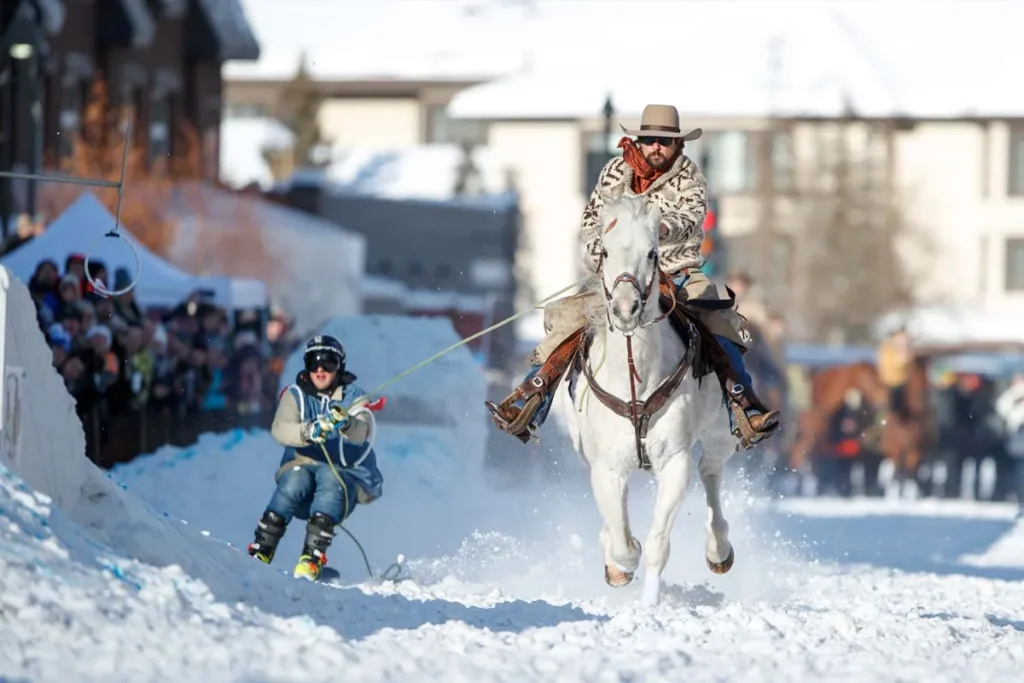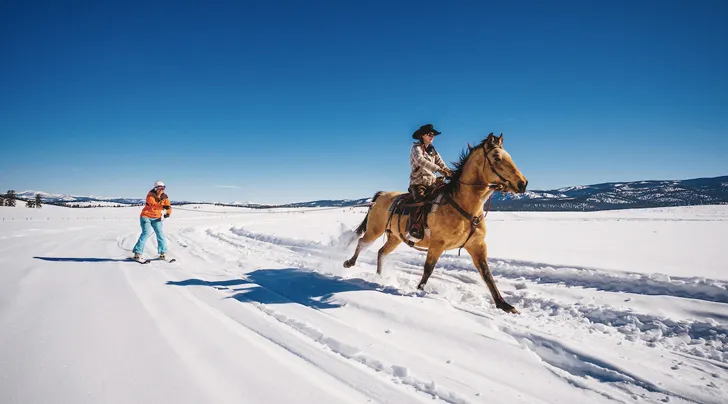Are you ready to amp up your winter adventures? If you crave excitement and a unique way to bond with your furry friend, skijoring might just be the perfect fit for you. Picture this: gliding effortlessly across snow-covered landscapes while being pulled by your enthusiastic pup. It’s a thrilling blend of skiing and dog sledding that will have both of you feeling exhilarated.
Whether you’re an avid skier or simply looking for a fun outdoor activity, discovering the thrill of skijoring can open up new horizons in winter sports. Let’s dive into five exciting things you need to know about this captivating sport!

Table of Contents
What is Skijoring?
Skijoring is an adventurous winter sport that combines cross-country skiing with the excitement of being pulled by a dog. Imagine strapping on your skis while your canine companion eagerly leads the way.
The word “skijoring” comes from the Norwegian word “skikjøring,” which means “ski driving.” It originated as a mode of transportation in snowy regions, but has since evolved into a popular recreational activity.
In skijoring, the skier wears a harness attached to a long rope or towline, which is then connected to a dog’s harness. As the dog runs ahead, the skier is pulled along on their skis. Skijoring can also be done with horses or even motorized vehicles, but using dogs is the most common and traditional method.
Skijoring requires teamwork and communication between the skier and their dog. The skier must use proper techniques to guide and control their speed, while the dog must respond to voice commands to follow a specific path and avoid obstacles.
This sport can be enjoyed by people of all ages and skill levels. It can be done on groomed trails or off-trail in open spaces, making it accessible for those who live in areas with snowy winters. Skijoring races are also held in some areas, where participants compete for speed and agility.

In addition to being a fun activity for both humans and dogs, skijoring provides great exercise for both parties — it’s a fantastic way to get your heart pumping and stay active during the winter months!
This exhilarating activity allows you to harness your dog’s energy, turning it into pure joy for both of you. As you glide across snowy trails, you’ll experience a unique bond and teamwork that few other sports can offer.
Originating from Norway in the late 19th century, skijoring has evolved into a popular pastime around the world. It’s perfect for those who enjoy outdoor activities during winter months and want to include their pets in the fun.
Whether you’re racing down slopes or peacefully navigating through serene forests, it offers an unparalleled sense of freedom and adventure on snow-covered terrain.
The History of Skijoring
Skijoring has roots that trace back to the Nordic countries, where it originated as a practical means of transportation. Early skiers would be pulled by dogs across snowy landscapes, allowing them to traverse difficult terrains with ease.
As skiing became a popular recreational activity, skijoring evolved into a sport. In the late 19th and early 20th centuries, military troops in Norway used skijoring as a training exercise, where soldiers would be pulled by horses or dogs to improve their skiing skills.

In the 1920s, skijoring was introduced to North America by Scandinavian immigrants. The sport gained popularity in the western United States and Canada, particularly in areas with heavy snowfall and strong equestrian traditions.
In the 1950s, skijoring competitions began to emerge in the United States and Canada. These early events were usually held at winter carnivals and featured traditional Nordic-style races where participants were pulled by horses or dogs.
In the 1970s, skiers started experimenting with using motorized vehicles like snowmobiles to pull them in skijoring races. This led to the creation of a new form of skijoring known as “motorized” or “engine-powered” skijoring.
Today, skijoring is practiced all over the world and has become a popular winter sport for both recreational enthusiasts and competitive athletes. The rules and equipment used may vary depending on the location and type of event, but the basic concept of being pulled by a dog or other animal remains the same.
As time passed, this functional activity transformed into a thrilling sport. The word “skijoring” itself stems from the Norwegian language, meaning “ski driving.”
In the early 20th century, adventurous souls began organizing competitions, showcasing both speed and teamwork between humans and their canine companions.
The sport gained popularity in North America during the mid-1900s as winter enthusiasts sought new activities beyond traditional skiing or snowboarding. Today, skijoring combines athleticism with fun for both participants and their furry friends while honoring its rich historical roots.
Equipment and Training
To embark on your adventure, the right equipment is essential. A sturdy pair of cross-country skis is a must. Look for models designed specifically for skijoring, as they offer better control and stability.
Next, you’ll need a harness tailored for your dog. This ensures a secure fit while allowing freedom of movement. Opt for one that distributes pressure evenly to avoid discomfort during those exhilarating runs. A skijoring belt is worn around the skier’s waist and connects to the dog’s harness through a bungee cord or towline. This allows for a smooth and comfortable ride, as the bungee absorbs any sudden movements or changes in speed.
Don’t forget about the leash! A specialized skijoring line attaches to both you and your pup, offering flexibility yet preventing tangling.
Training plays an equally vital role in this thrilling sport. Start with basic commands like “go,” “stop,” and “turn.” Gradually introduce them on snow-covered trails to help your dog acclimate to pulling you along.
Practice makes perfect—consider short sessions at first before tackling longer distances together. Building trust between you and your furry partner enhances the experience immensely.
Top 5 Places to Try
If you’re itching to experience the thrill, several locations stand out for their breathtaking scenery and excellent trails.
First up is Lake Tahoe in California. The mix of stunning views and well-groomed routes makes it a favorite among enthusiasts.
Next, check out Colorado’s Vail Valley. This area offers diverse terrain ideal for both beginners and seasoned pros.
For something unique, consider Yellowstone National Park in Wyoming. Skijoring here lets you enjoy winter wildlife while gliding through iconic landscapes.
Another amazing spot is Leadville, also in Colorado. Known as one of the highest towns in the U.S., its crisp air enhances your adventure.
Don’t miss Anchorage, Alaska. The vast open spaces provide an exhilarating backdrop that adds to the excitement of your journey with your furry friend.
Benefits of Skijoring for You and Your Dog
Skijoring offers a fantastic way to bond with your dog while getting some fresh air and exercise. The thrill of gliding over snow, powered by your furry companion, creates an exhilarating experience for both of you.
For dogs, skijoring provides mental stimulation. Navigating snowy trails engages their instincts and keeps them alert. It’s not just fun; it builds confidence too.
On the human side, skijoring is an excellent workout that combines cardio with strength training. You can burn calories while enjoying the great outdoors.
This activity also fosters teamwork between you and your dog. Learning to communicate effectively enhances your relationship.
Moreover, being outside in nature boosts mood and reduces stress levels for both pet owners and their four-legged friends alike. Embrace this winter adventure together!
Safety Precautions and Tips
Safety is paramount when engaging in skijoring, both for you and your furry companion. Start by ensuring your dog is physically fit and trained for the activity. A well-prepared dog will enjoy themselves more and perform better.
Always use appropriate gear, including a properly fitted harness that distributes pressure without causing discomfort. The leash should be durable yet lightweight to allow freedom of movement while maintaining control.
Choose safe terrain, away from crowded areas or obstacles like trees and fences. Check snow conditions before heading out; icy patches can pose risks for both you and your pup.
Stay hydrated during breaks, as winter activities can still lead to dehydration. Keep an eye on the signs of fatigue in your dog—if they seem tired or disinterested, it’s time to call it a day.
Maintain clear communication with your pet throughout the experience as this fosters trust and enhances safety on the trails.
Conclusion
Skijoring is an exhilarating sport that combines the thrill with the companionship of our furry friends. It’s a unique experience that allows you and your dog to bond while enjoying the great outdoors together. Whether you’re looking for an adrenaline rush or just a fun way to stay active during winter, skijoring offers something special.
As you embark on this adventure, remember to prioritize safety—for both you and your canine companion. With the right equipment, training, and knowledge of proper techniques, you’ll be well on your way to mastering this exciting activity.
From its rich history rooted in practicality to modern-day competitions showcasing incredible skills, skijoring is sure to captivate anyone who tries it. So grab your gear and hit the trails—unleash the thrill of skijoring today!
Click here for related details.
Stay tuned on Travelyas for insight details.

